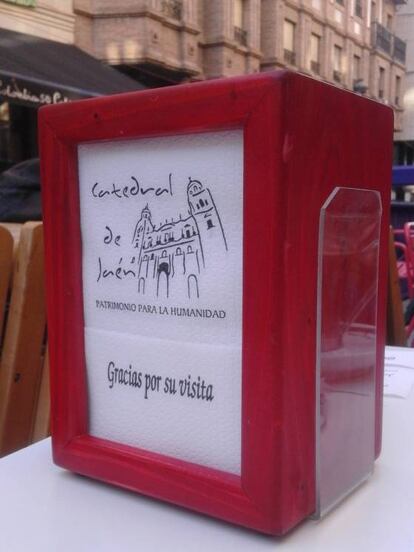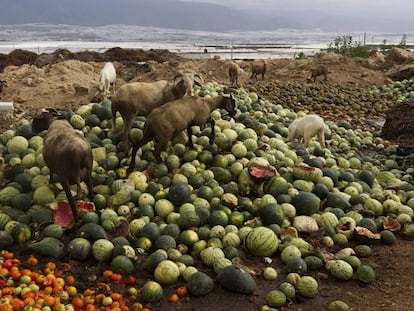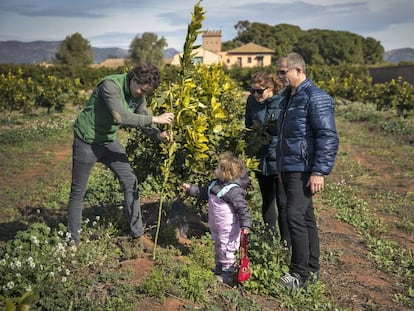The Spanish “anti-napkin” – why does it still exist?
Unlikely as it may sound, there is a role in life for those old-fashioned wipes that do such a poor job of cleaning

You’re making a greasy mess of yourself eating that jamón. Not to mention the olives. And the croquetas. And the shrimp. You are starting to see condensation form on your beer mug and soon there’s a puddle of water on the table. But no matter how many napkins you pull out of the holder, they are useless against the elements. What’s worse, you now face a pile of scrunched-up paper that you don’t know what to do with.
You know exactly who to blame: those useless napkins found at Spanish bars that don’t absorb a single drop of liquid. But why on Earth do these anti-napkins still exist?

I don’t know whether there is a single Spaniard who hasn’t come across these infernal napkins at one point or another. So let’s find out their real name. The industry knows them as “sulfite paper napkins, glazed on one side.” When they come in those flat holders, they are referred to as “zigzag napkins” because of the way each one is folded into the previous one. And when they come in the vertical holders – you know, the kind where you try to pull one out and around 30 come out at the same time – they are called “miniservis,” just like the spring-activated container that holds them.
I haven’t learned all of these things due to a lifetime of going to bars and getting hopelessly filthy. I found them out from talking to Pablo Aguilella, who works at Caricias, a firm that makes napkins, tablecloths, coasters and, yes, miniservis. “Let me tell you right now, I can’t figure out why these are still sold,” says Aguilella. “There are cheaper alternatives, such as cellulose tissue, which actually dries and cleans.”
The average wholesale price of the anti-napkins is around €25 for a pack of 12,000, which is €0.002 per unit. According to Aguilella, it’s not about the price, it’s about the look. “Each bar personalizes them with their own logo, which looks better on glazed paper.”

To him, the obvious alternative would be the two-layer, 20x20cm napkins that are typically used as coasters under a drink, to prevent a ring from forming on the countertop. “Those have a slightly rough feel that is ultimately what does the job of cleaning.”
For better or for worse, Aguilella informs me that there are hardly any manufacturers left in the world that still make the so-called zigzag napkins, which have edges decorated with planes, chains and other motifs. What’s popular now are products marketed as environmentally friendly. “We’ve seen more than 300% growth in these products,” he says.
Over at Comercial El Maño, a supplier of the food and beverage industry, José Antonio Montolío confirms that there’s been a significant drop in sales of anti-napkins. “I am barely selling any, and the buyers are old-fashioned businesses whose owners ignore our recommendations for other products. These have fallen into disuse.”
Montolío notes that even though recycled napkins are selling better than ever, they have always existed. “Now they come in a brown color, without the chlorine treatment to whiten them.”
At this point, you may be wondering what’s going on in Spain for us to cling to these anti-napkins. But we are not alone. This article published in Argentina’s La Nación also complains about the plague of anti-napkins, which are common in that country’s pizzerias and bars. And it’s a similar story in Poland, as the blogger Pepe Mansilla rightfully laments.

But some people choose to look beyond functionality, and see potential in these products. The Madrid photographer Felipe Hernández has been running an Instagram account about napkins (@servilletas) for the last two years. Although he is guided by esthetics, he has the following to say: “Those napkins encapsulate Spain’s gastronomic culture, its territorial differences; in short, the nation’s graphic identity.”
And there is no lover of Spanish food culture who can resist passing fashions quite like Alberto García Moyano (@enocasionesveobares). A lawyer, co-owner of the eateries Bodega Carol and Sants Es Crema, founder of Bodega Montferry and a know-nearly-all on all things bar-related, he has the following to say about the anti-napkins: “They seem like perhaps the most useless item in the world to me. Yet at the same time I am inordinately fond of them – I love seeing them, I think it’s such a nice gesture on the bar owner’s part. It’s probably to do with nostalgia.”
I have a theory of my own that I share with García Moyano: for several years now, I’ve entertained the thought that these anti-napkins could be a good sign, a sign that the bar that has them does something well. “Seeing a bar with this kind of napkin draws me in,” agrees García Moyano. “It’s like they’re making a statement:‘I have these napkins and there’s a reason for it – because there’s something in here that I know you might like.’ And I’m not talking about posers, but about people who might be more naturally inclined to go to these kinds of establishments.”
García Moyano also has good things to say about the liquid-repellent qualities of the anti-napkin. “That kind of material is more useful than you think. The fact that they are slightly waterproof means that there’s a 99.99% chance that if you wrap a sandwich in them, as we do at Bodega Montferry, the fricandeau sauce will not soak through.” (Yes my friends, Bodega Montferry makes fricandeau sandwiches and many other marvelous things besides).
“I get really upset when a sandwich that’s oozing delicious fat or sauce gets wrapped in those super-absorbent napkins. It’s as though they were swallowing up food meant for me! The glazed napkin, instead, gives it back to you so you can eat it. And that’s a wonderful thing, because you get a 100% return on your investment in a great, big, honking, dripping sandwich,” he continues, rapturously. “As a matter of fact, these napkins deserve global gratitude from all of civilization.”
English version by Susana Urra.
Tu suscripción se está usando en otro dispositivo
¿Quieres añadir otro usuario a tu suscripción?
Si continúas leyendo en este dispositivo, no se podrá leer en el otro.
FlechaTu suscripción se está usando en otro dispositivo y solo puedes acceder a EL PAÍS desde un dispositivo a la vez.
Si quieres compartir tu cuenta, cambia tu suscripción a la modalidad Premium, así podrás añadir otro usuario. Cada uno accederá con su propia cuenta de email, lo que os permitirá personalizar vuestra experiencia en EL PAÍS.
¿Tienes una suscripción de empresa? Accede aquí para contratar más cuentas.
En el caso de no saber quién está usando tu cuenta, te recomendamos cambiar tu contraseña aquí.
Si decides continuar compartiendo tu cuenta, este mensaje se mostrará en tu dispositivo y en el de la otra persona que está usando tu cuenta de forma indefinida, afectando a tu experiencia de lectura. Puedes consultar aquí los términos y condiciones de la suscripción digital.
More information
Archived In
Últimas noticias
The complicated life of Francesca Albanese: A rising figure in Italy but barred from every bank by Trump’s sanctions
Reinhard Genzel, Nobel laureate in physics: ‘One-minute videos will never give you the truth’
Pinochet’s victims grapple with José Antonio Kast’s rise in Chile
How Japan is trying to avert ‘digital defeat’
Most viewed
- Pablo Escobar’s hippos: A serious environmental problem, 40 years on
- Reinhard Genzel, Nobel laureate in physics: ‘One-minute videos will never give you the truth’
- Why we lost the habit of sleeping in two segments and how that changed our sense of time
- Charles Dubouloz, mountaineering star, retires at 36 with a farewell tour inspired by Walter Bonatti
- The Florida Keys tourist paradise is besieged by immigration agents: ‘We’ve never seen anything like this’










































